
A tide pool or rock pool is a shallow pool of seawater that forms on the rocky intertidal shore. These pools typically range from a few inches to a few feet deep and a few feet across. Many of these pools exist as separate bodies of water only at low tide, as seawater gets trapped when the tide recedes. Tides are caused by the gravitational pull of the sun and moon. A tidal cycle is usually about 25 hours and consists of one or two high tides and two low tides.

Limpets are a group of aquatic snails that exhibit a conical shell shape (patelliform) and a strong, muscular foot. Limpets are members of the class Gastropoda, but are polyphyletic, meaning the various groups called "limpets" descended independently from different ancestral gastropods. This general category of conical shell is known as "patelliform" (dish-shaped). All members of the large and ancient marine clade Patellogastropoda are limpets. Within that clade, the members of the Patellidae family in particular are often referred to as "true limpets".

The Patellogastropoda, common name true limpets and historically called the Docoglossa, are members of a major phylogenetic group of marine gastropods, treated by experts either as a clade or as a taxonomic order.

Patellidae is a taxonomic family of true limpets, marine gastropod molluscs in the superfamily Patelloidea. (The superfamily Patelloidea should not be confused with the similar-sounding genus of true limpets Patelloida which is in the family Lottiidae within the superfamily Lottioidea, also part of the Patellogastropoda.)
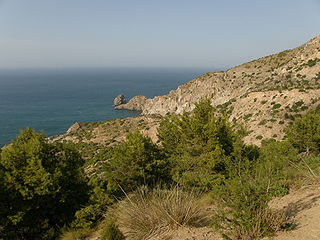
Al Hoceima National Park is a national park located outside the town of Al Hoceima in Morocco. It covers an area of 480 km2 (185 sq mi), including 196 km2 (76 sq mi) of sea. The park was created in 2004 and is managed by the Haut-Commissariat des eaux et forêts et de la lutte contre la désertification.

Cellana sandwicensis, common name the yellow-foot ʻopihi, is a species of edible true limpet, a marine gastropod mollusc in the family Nacellidae, one of the families of true limpets.

Seashore wildlife habitats exist from the Tropics to the Arctic and Antarctic. Seashores and beaches provide varied habitats in different parts of the world, and even within the same beach. Phytoplankton is at the bottom of some food chains, while zooplankton and other organisms eat phytoplankton. Kelp is also autotrophic and at the bottom of many food chains. Coastal areas are stressed through rapid changes, for example due to tides.
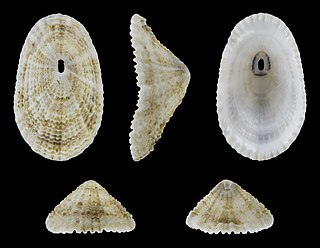
Diodora graeca, the Greek keyhole limpet, is a sea snail or limpet, a marine gastropod mollusk in the family Fissurellidae, the keyhole limpets.

Diodora italica, the keyhole limpet or Italian keyhole limpet, is a sea snail or limpet, a marine prosobranch gastropod mollusk in the family Fissurellidae, the keyhole limpets.

Lottia gigantea, common name the owl limpet, is a species of sea snail, a true limpet, a marine gastropod mollusc in the family Lottiidae. Its genome has been sequenced at the Joint Genome Institute.

Pachygrapsus marmoratus is a species of crab, sometimes called the marbled rock crab or marbled crab, which lives in the Black Sea, the Mediterranean Sea and parts of the Atlantic Ocean. It is dark violet brown, with yellow marbling, and with a body up to 36 millimetres (1.4 in) long. A semiterrestrial omnivore, it feeds on algae and various animals including mussels and limpets.

Lottia digitalis, commonly known as the fingered limpet or ribbed limpet, is a species of sea snail, a true limpet, a marine gastropod mollusk in the family Lottiidae. These limpets are usually found on the surface of rocks in the high intertidal region on the coastal fringes of the north-eastern Pacific Ocean.

Lottia persona is a species of sea snail, a true limpet, a marine gastropod mollusk in the family Lottiidae, one of the families of true limpets.

Lottia scabra or the rough limpet is a species of sea snail, a true limpet, a marine gastropod mollusk in the family Lottiidae.
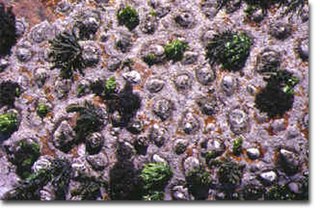
Scutellastra cochlear is a species of sea snail, a marine gastropod mollusc in the family Patellidae, one of the families of true limpets. It is commonly known as the snail patella, the pear limpet or the spoon limpet and is native to South Africa. It often grows in association with the crustose coralline alga Spongites yendoi and a filamentous red alga which it cultivates in a garden. It was first described by the malacologist Ignaz von Born in 1778 as Patella cochlear.

Diodora aspera, also known as the rough keyhole limpet, is a species of sea snail, a marine gastropod mollusk in the family Fissurellidae, the keyhole limpets. Although similar in appearance to a common limpet, it has a hole near the apex of its shell, and is only distantly related. It often has a scaled polychaete worm Arctonoe vittata living inside its shell as a commensal. In the event that it is attacked by a starfish, it extends flaps of mantle to defend itself, and the worm also helps drive the predator away.

Diodora funiculata is a species of sea snail, a marine gastropod mollusk in the family Fissurellidae, the keyhole limpets.
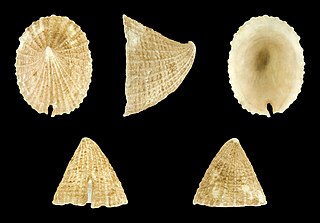
Emarginula fissura, the common slit limpet, is a species of sea snail, a marine gastropod mollusk in the family Fissurellidae, the keyhole limpets.

Semibalanus cariosus, commonly known as the thatched barnacle, rock barnacle or horse barnacle, is a species of acorn barnacle occurring in the northern Pacific Ocean.
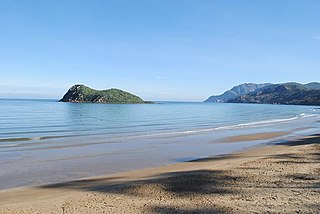
Cala Iris Islet is a small island in Morocco, located in the Alboran Sea in the bay of the Cala Iris village, Al Hoceima Province. It is about 500 m off the Cala Iris beach. This island is a part of the Al Hoceima National Park. Cala Iris Islet is one of the few places where the ribbed Mediterranean limpet has survived, with a population of 110 specimens.





















